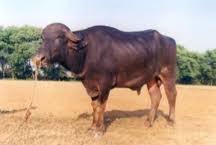Dharwari
Dharwari buffaloes are also known as Holesal or Mundargi buffaloes. Previous reports opined that Pandharpuri buffaloes in North Karnataka are called Dharwari. Eighty per cent of the buffaloes found in Karnataka are of this type (Jayashankar and Govindaiah, 2001). The buffaloes are found in Dharwar, Belgaum and Bijapur districts of northern Karnataka, closely resembling Pandharpuri. A strong herding instinct is the characteristic behaviour of the breed, with the male acting as leader; but docile in nature.
Medium-sized animals. Body length, height at withers and chest girth range from 150-175, 125-142 and 200-215 cm, respectively. Body is slate blackish in colour, covered with long hairy coat. Hair at chest floor, abdominal region and on legs appear dense. Horns are projected laterally and backward from the head, long, flat and sweeping in nature; usually carried parallel to neck almost crossing the shoulder blade, ending with sharp upward point. Tail hangs below the hock joint, seldom touching the ground.
The buffaloes calve at the age of 4-4½ years. They are regular calvers with a calving interval of 14-16 months. The buffaloes yield milk with a range of 500 – 1500 kg in a lactation period of 265 – 325 days. The buffaloes are maintained by the tribal community Gavali or Gowli, spread over western ghats and in suburban areas of taluks in Belgaum, Dharwar and North Kanara districts. Only natural service is followed, as the tribal people are reluctant to adopt Artificial Insemination. The women folk of the community are ardent lovers and totally dedicated to raising of buffaloes for milk production. A distinct feature of varietals cutting of the ears of these buffaloes is done for identification and beautification.
source: PS RAHUMATHULLA

